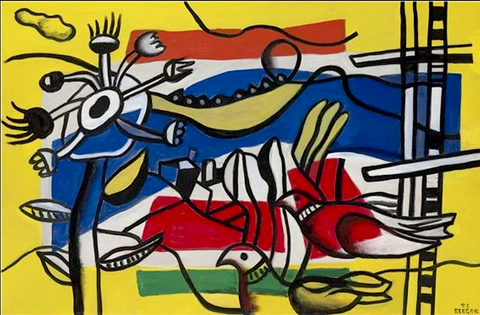Series - Birds in art
Whaaa!
A print by Ohara Koson circa 1900.
A rarity, this costume design for the creation of the world, "Le Parroquet" 1923 by Léger Fernand.
The first performance of "The Creation of the World" took place on October 25, 1923 at the Théâtre des Champs-Élysées in Paris - Plot Blaise Cendrars, music Darius Milhaud, choreography Jan Börlin, sets and costumes Fernand Léger. Not bad is not it ?
Paul Klee, “Landscape with Yellow Birds”, 1923.
The Maeght Foundation devoted a major retrospective to him in 1977.
Ahahah! This bird is incredible, isn’t it?
Pablo Picasso, “The Bird”, 1928.
Green, more green, with André Beaudin, “The White Birds” from 1933.
.
Few exhibited works by this artist from "L'Ecole de Paris", this painting is part of the collections of the Center Pompidou, but is rarely exhibited
A beautiful blue for a walk with Miró, "Birds and Insects", 1938.
For my birds series, I dive into the myth of Leda and the swan. This rascal Zeus took the form of a white swan to seduce Leda at night, according to Homer. Leda is the daughter of Thestios, king of Aetolia and her husband is Tyndareus, king of Sparta. From her love affair with the god, Leda conceived two children, Helen and Pollux, who were born in an egg,
There are many works representing this myth.
Salvador Dali, "Atomic Leda" Dali said: "it is the picture of our life. Everything is suspended in space without anything touching. Even the sea rises at a distance from the earth." It is of course his wife, Gala, who lends her features to Leda.
When he painted this canvas, Dali was in his period of corpuscular mysticism. Fascinated by the invention of the atomic bomb and by nuclear physics, he saw it as a new source of creation. Thus, matter would not be a single entity, but a multitude of particles linked together by vacuum, which implies a form of weightlessness.
Joan Miró, “Characters and birds in front of the sun”, 1946.
Joan Miró, “Women and birds at sunrise”, 1946.
Joan Miró, "Women and birds in the night", 1947
Karel Appel, “Child and Birds”, 1950.
Bird series with this superb Victor Brauner.
The most surrealist of poets or the most poetic of surrealists?
Miró, “Family of Birdcatchers”. Talent in litho.
Georges Braque, “A tire of wing”, 1956-1961.
What a painting! What modernity, it is timeless for me, everything is confusing. The framing, with this rectangle at the bottom, left. The material, with the paint which seems to drown sand, gravel. The subject, this bird which looks like a fighter plane swooping down on a target.
When I was very little, Monsieur Braque was, for me, like a grandfather, also because my Grandpa, Aimé Maeght, seemed so young. Braque was his mentor, he exhibited at the Galerie Maeght from 1945 and until his death in 1963.
Georges Braque, “The Black Birds”, 1957.
Birds series, with this magnificent “Zephyr Bird” by Joan Miró.
Miró is genius served by an extraordinary sense of technique. Here, with this litho published by my grandfather Aimé Maeght, he knows how to use the transparencies of lithographic inks so well to give relief and create materials. A sober use, few colors, few passages in the press, but damn what an explosive result.
Marc Chagall, “The Blue Bird”, 1968.
Honestly, isn't it magical to paint like that at 90?
Picasso, “Bust of a woman with a bird”. 1971
“Peace”, 1972 by Alexander Calder who was involved against the Vietnam War from the start.
One of the most beautiful birds for my series!
Miró, “Head, bird”, 1974.
Not even afraid !
Incredibly contemporary.
Perfect for my bird series.
Robert Combas, “Bird among flowers”. I can't help but think that if Combas were American everyone would cry genius.
A typical work of free figuration, Robert Combas, "In Search of the Firebird", 1987.
Ross Bleckner, "Cage", 1987.
The bird is not trapped there, fortunately.
Considered one of the main representatives of Chinese cynical realism, a movement characterized by a shattered idealism following the events of the 1980s, Yue Minjun paints himself with this big mouth with forced laughter.
In this iconic painting, the character wraps his body around a penguin, a flightless bird. Is the bird laughing or suffering?
Yue Minjun, “Penguin”, 2000.
You will gain a little wing again, Mr. Hitchcock!
Photo Halsman.
Picasso Perch!
A quality perch!
Matisse













 Fernand Léger, frontispiece to “A Poem in Every Book” 1955.
Fernand Léger, frontispiece to “A Poem in Every Book” 1955.















